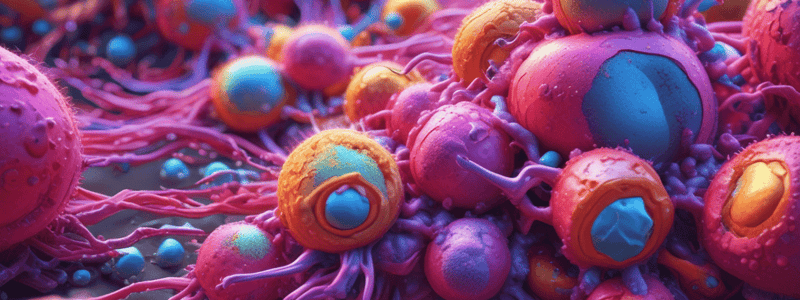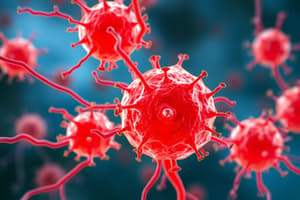Podcast
Questions and Answers
Which type of immunity involves the recipient receiving antibodies produced by another person, animal, or synthetically?
Which type of immunity involves the recipient receiving antibodies produced by another person, animal, or synthetically?
- Artificially acquired passive immunity (correct)
- Artificially acquired active immunity
- Naturally acquired active immunity
- Naturally acquired passive immunity
Which type of immunity involves the person receiving a vaccine of dead, weakened, or inactivated pathogens or their antigenic parts?
Which type of immunity involves the person receiving a vaccine of dead, weakened, or inactivated pathogens or their antigenic parts?
- Artificially acquired passive immunity
- Naturally acquired active immunity
- Naturally acquired passive immunity
- Artificially acquired active immunity (correct)
What is the primary purpose of booster shots in the context of immunity?
What is the primary purpose of booster shots in the context of immunity?
- To trigger a primary immune response
- To cause a secondary response to boost antibody levels (correct)
- To reject organ transplants
- To provide passive immunity
What is the major challenge faced after an organ transplant?
What is the major challenge faced after an organ transplant?
What is the purpose of comparing human leukocyte antigens (HLAs) between the donor and recipient in an organ transplant?
What is the purpose of comparing human leukocyte antigens (HLAs) between the donor and recipient in an organ transplant?
What type of immunity is achieved when a person receives a vaccine containing dead or weakened pathogens?
What type of immunity is achieved when a person receives a vaccine containing dead or weakened pathogens?
Which immune response is responsible for forming memory T and B cells in the body?
Which immune response is responsible for forming memory T and B cells in the body?
What type of immunity is acquired when infants receive maternal antibodies IgG through the placenta?
What type of immunity is acquired when infants receive maternal antibodies IgG through the placenta?
In what situation is artificially acquired passive immunity typically used?
In what situation is artificially acquired passive immunity typically used?
What is the major challenge faced after organ transplantation?
What is the major challenge faced after organ transplantation?
Which type of immunity involves the production of antibodies by B cells in response to a specific antigen?
Which type of immunity involves the production of antibodies by B cells in response to a specific antigen?
Which type of immunity involves the transfer of pre-formed antibodies from one individual to another, providing immediate but temporary protection?
Which type of immunity involves the transfer of pre-formed antibodies from one individual to another, providing immediate but temporary protection?
Which type of immune response occurs the first time the body encounters a specific antigen?
Which type of immune response occurs the first time the body encounters a specific antigen?
Which type of immune response is characterized by a faster and more robust antibody production upon subsequent exposure to the same antigen?
Which type of immune response is characterized by a faster and more robust antibody production upon subsequent exposure to the same antigen?
Which type of immunity is acquired through the transfer of antibodies from a mother to her infant during pregnancy or breastfeeding?
Which type of immunity is acquired through the transfer of antibodies from a mother to her infant during pregnancy or breastfeeding?
What is the primary difference between primary and secondary immune responses?
What is the primary difference between primary and secondary immune responses?
Which of the following statements about active immunity is incorrect?
Which of the following statements about active immunity is incorrect?
In the context of passive immunity, which of the following statements is true?
In the context of passive immunity, which of the following statements is true?
What is the primary function of memory cells in the immune system?
What is the primary function of memory cells in the immune system?
Which of the following is an example of naturally acquired active immunity?
Which of the following is an example of naturally acquired active immunity?
Which of the following statements accurately describes the primary immune response?
Which of the following statements accurately describes the primary immune response?
Which of the following statements accurately describes the secondary immune response?
Which of the following statements accurately describes the secondary immune response?
Which of the following statements accurately describes active immunity?
Which of the following statements accurately describes active immunity?
Which of the following statements accurately describes passive immunity?
Which of the following statements accurately describes passive immunity?
Which of the following statements accurately describes naturally acquired active immunity?
Which of the following statements accurately describes naturally acquired active immunity?
Which of the following best describes the role of T cells in delayed hypersensitivity reactions?
Which of the following best describes the role of T cells in delayed hypersensitivity reactions?
Which of the following disorders is characterized by the production of antibodies against self-antigens?
Which of the following disorders is characterized by the production of antibodies against self-antigens?
In the case of anaphylaxis, what is the primary mechanism that leads to life-threatening symptoms?
In the case of anaphylaxis, what is the primary mechanism that leads to life-threatening symptoms?
Which of the following is a characteristic feature of Hodgkin lymphoma?
Which of the following is a characteristic feature of Hodgkin lymphoma?
Which of the following best describes the mechanism underlying passive immunity?
Which of the following best describes the mechanism underlying passive immunity?
Which of the following is NOT a characteristic of a primary immune response?
Which of the following is NOT a characteristic of a primary immune response?
Active immunity can be acquired through which of the following processes?
Active immunity can be acquired through which of the following processes?
What is the primary difference between active and passive immunity?
What is the primary difference between active and passive immunity?
In the context of a secondary immune response, which of the following statements is FALSE?
In the context of a secondary immune response, which of the following statements is FALSE?
Which type of immunity is conferred by the placental transfer of antibodies from mother to fetus?
Which type of immunity is conferred by the placental transfer of antibodies from mother to fetus?
Which of the following is NOT a type of adaptive immunity?
Which of the following is NOT a type of adaptive immunity?
Which cells are primarily responsible for cell-mediated immunity?
Which cells are primarily responsible for cell-mediated immunity?
What is the primary function of antibodies in the immune response?
What is the primary function of antibodies in the immune response?
Which of the following is NOT a component of nonspecific resistance?
Which of the following is NOT a component of nonspecific resistance?
What is the primary mechanism by which vaccines provide immunity?
What is the primary mechanism by which vaccines provide immunity?
Flashcards are hidden until you start studying
Study Notes
Immune Response
- Primary immune response occurs when the body encounters a pathogen or non-self antigen for the first time, stimulating T and B cells to become activated and proliferate to destroy the antigen.
- Primary immune response produces memory cells that recognize the same antigen if it reenters the body.
- Secondary immune response occurs when the body encounters the same antigen again, and memory T and B cells launch a more rapid and intense response than the primary immune response.
Types of Immunity
- Active immunity: acquired through the use of a person's immune response, leading to the development of memory cells.
- Passive immunity: acquired without the activation of a person's immune response, with no memory developed.
Active Immunity
- Naturally acquired active immunity: results from exposure to a pathogen, where the person gets sick and recovers, leaving antibodies and memory T and B cells to fight later infections.
- Artificially acquired active immunity: occurs when a person receives a vaccine of dead, weakened, or inactivated pathogens or their antigenic parts, triggering a primary immune response that forms memory T and B cells and antibodies.
Passive Immunity
- Naturally acquired passive immunity: occurs when infants receive maternal antibodies (IgG) through the placenta and IgA in breast milk.
- Artificially acquired passive immunity: occurs when receiving injections of antibodies produced by another person, animal, or synthetically (called antiserum), used in emergency situations when the pathogen acts too severely and quickly.
Rejection of Organ Transplants
- Organ transplants are viable treatment options for persons with terminal diseases of certain organs.
- The lymphoid system recognizes the new organ as non-self and attacks it, leading to organ rejection.
- To limit the chance of rejection, compatibility of donor and recipient tissues is determined by comparing human leukocyte antigens (HLAs).
Noninfectious Disorders
- Allergy or hypersensitivity: occurs when allergens bind with IgE antibodies on mast cell surfaces, leading to an inflammatory response.
- Autoimmune diseases: T and B cells recognize body tissues as non-self, producing an immune response, e.g., rheumatoid arthritis and type I diabetes.
- Lymphoma: any tumor of lymphoid tissue, e.g., Hodgkin lymphoma.
- Severe combined immunodeficiency (SCID): a group of disorders resulting from genetic defects, leading to a marked deficit or absence of both T and B cells, making the lymphoid system nonfunctional.
Antibody-Mediated Immunity
- Antibodies: proteins known as globulins or immunoglobulins, e.g., IgG and IgA.
- Antibody-mediated immunity: occurs when antibodies form antigen-antibody complexes that mark pathogens for destruction, and are engulfed and destroyed by macrophages, eosinophils, and neutrophils.
- Antibodies do not destroy pathogens directly but neutralize bacterial toxins by binding to antigens, preventing them from attaching to receptors of body cells.
Studying That Suits You
Use AI to generate personalized quizzes and flashcards to suit your learning preferences.




